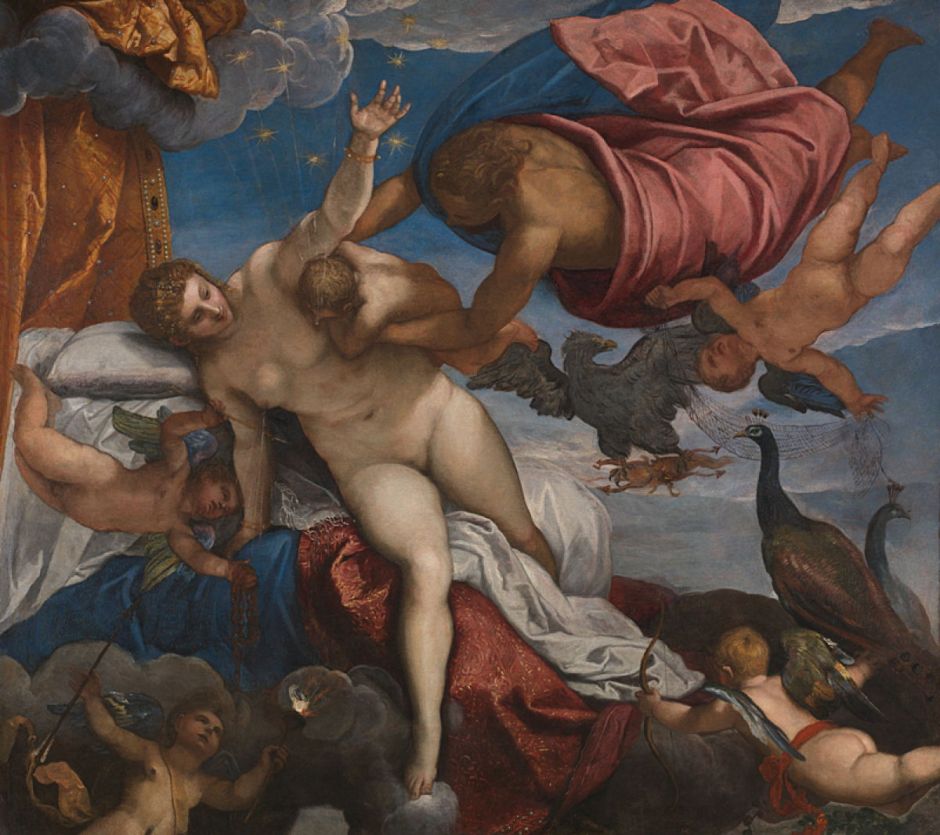Like her brother and spouse Zeus/Jupiter, Hera (Greek Ἥρᾱ, Latin Juno) is a child of the Titans Kronos and Rhea. Acting as a matronly Queen of the deities of Olympus, she is normally associated with women, marriage and childbirth. In painting, her most usual attribute is her favourite bird, the peacock, but she’s also associated with the cow, pomegranate fruit, and several other symbols which are seen only rarely.

Gustave Moreau’s Peacock Complaining to Juno of 1881 shows one of Aesop’s fables (told in Phaedrus III.18), in which Hera’s favourite peacock complained to the goddess that it didn’t have the voice of a nightingale. Hera responded by saying that fate had assigned each bird its properties, and the peacock should be content with its lot. This exquisite watercolour adds the ominous form of Zeus’s eagle, keeping a watchful eye on his wife from a nearby cloud.
Despite her matronly image, Hera is portrayed as young and physically attractive, and is one of the three contestants in the Judgement of Paris.

In Jacob Jordaens’ Golden Apple of Discord, the discordant Eris, in midair behind the deities, has just made her gift of the golden apple which initiates the beauty contest. At the left, Pallas Athena reaches forward for it. In front of her, Aphrodite, her son Eros at her knee, points to herself as the goddess most deserving of the apple. On the other side of the table, Hera reaches her hand out for it too.

Rubens’ late version of The Judgement of Paris from 1632-35 shows the three competing deities; from the left are Athena with her shield, Aphrodite, and Hera with her peacock. Paris is just about to give Aphrodite the golden apple of discord, as Hermes leans on the tree behind.
Hera appears most frequently in myth when she is trying to subvert Zeus’s frequent adulterous rapes and seductions. One of the most elaborate of these involves Io, whom Zeus turns into a cow in an attempt to hide her from Hera, who in turn gains control over Io, and puts Argus to watch over her. Zeus then sends Hermes/Mercury to kill Argus and release Io to him.

Rubens painted several versions of Hermes about to kill Argus but this painting of Juno and Argus (c 1611) shows the conclusion of this part of the story. Hera, wearing the red dress and coronet, is receiving eyes which have been removed from Argus’ head, and is placing them on the tail feathers of her peacocks. The headless corpse of Argus lies contorted in the foreground. Rubens has introduced a visual joke, in which Hera’s left hand appears to be cupped under the breasts of the woman behind.
Hera also had a more matronly role to play in the myth of Heracles/Hercules.

According to older Greek myths, the sons of Zeus could only become divine if they were suckled at Hera’s breast. Shortly after the birth of Heracles, Hermes took the infant to Hera, who put him to her breast. When she realised who the baby was, she pulled him off the breast, and the excess milk which was released as a result sprayed over the heavens, forming the Milky Way.
Tintoretto’s wonderful painting shows the infant Heracles being pulled away from Hera’s breast by an anonymous assistant, with fine streams of milk gushing upwards to generate individual stars, and downwards to form lilies. In the background, Zeus’s eagle has a crablike object in its talons, perhaps representing the constellation of the Crab (Cancer), and Hera’s peacocks are at the right.

Just a few years before his death, Rubens painted his wonderful version, The Birth of the Milky Way (1636-37). Zeus sits in the background on the left, seemingly bored. Hera’s milk arcs out from her left breast over the heavens, and her peacocks look distressed.
Other myths hold that Hera was still furious that Heracles had been born, so she placed two serpents in his cradle, in an attempt to kill the child. Heracles’ mortal twin Iphicles screamed at the snakes, bringing their father Amphitryon running. He found Heracles strangling the serpents with his bare hands: proof that he was indeed the son of Zeus.
Although Hera was looked on by women as their goddess, her treatment of mortal women was often retributive in the extreme.
When Zeus rapes Callisto and she falls pregnant, Artemis throws the mortal out of her band of chaste followers. Once her son is born, Hera drags her away by her hair, and turns her into a bear. Later, when Callisto’s son Arcas is just about to kill her, Zeus finally takes pity on them and catasterises them into the Great and Little Bear constellations.

This painting of Jupiter and Callisto from about 1630, attributed to Karel Philips Spierincks, uses multiplex narrative to great effect: in the distance, we see Hera dragging Callisto along by her hair.
Hera isn’t content that Callisto has become a constellation, and wants to ensure that her husband can’t sneakily turn her back into a human. She therefore instructs the gods of the sea that they shan’t let either constellation sink below the horizon. Indeed, in Greece and Italy at that time, neither Ursa Major nor Ursa Minor ever set below the horizon.
As Hera puts it, “thus the guilty rue their chastisement!” and she sails off through the heavens in her chariot drawn by peacocks.

